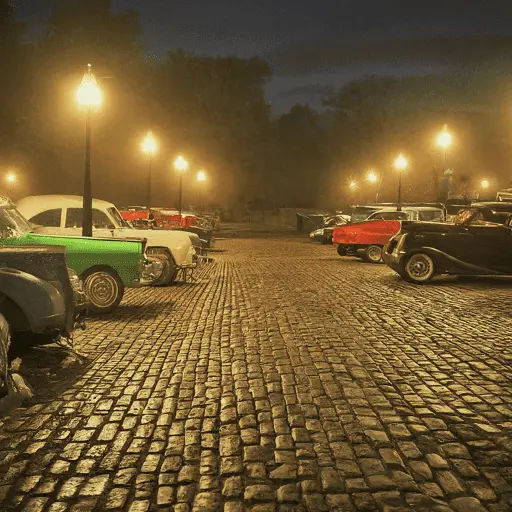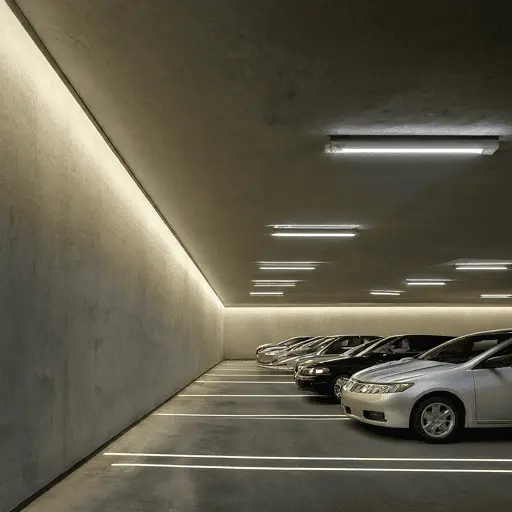Proper lighting in parking lots is crucial for maintaining safety, security, and an overall pleasant experience for visitors. Whether you manage a commercial space, a public facility, or a private property, ensuring that your parking lot is well-lit can significantly reduce accidents and deter criminal activity.
In this guide, we’ll explore everything you need to know about selecting the best parking lot lights, from understanding the different types available to knowing what factors to consider before making a purchase. This comprehensive buyer’s guide is designed to help property owners and managers make informed decisions to enhance the safety and appeal of their spaces.
Importance of Parking Lot Lighting
A. Safety Concerns
Parking lot lighting plays a vital role in preventing accidents, particularly pedestrian and vehicle collisions. Adequate lighting ensures that drivers and pedestrians can see each other clearly, reducing the risk of mishaps. Additionally, well-lit parking lots improve visibility during low-light conditions, such as at night or during bad weather, allowing drivers to navigate safely.
B. Security Concerns
A well-lit parking lot serves as a deterrent to theft, vandalism, and other criminal activities. Bright, consistent lighting eliminates dark corners where criminals might hide, creating a safer environment for both visitors and employees. Enhanced visibility increases the sense of security, making people feel more comfortable when accessing the parking lot, especially during evening hours.
C. Aesthetic Impact
Beyond safety and security, parking lights also has a significant aesthetic impact on the property. Properly designed lighting can elevate the appearance of commercial and public properties, making them more inviting and professional. The way a parking lot is lit often shapes the first impression of a business or venue, reflecting the quality and attention to detail of the establishment.
Types of Parking Lot Lights
There are several types of parking light fixtures designed to enhance safety, visibility, and aesthetics. Here are the primary types of parking lot lights:
| Type of Parking Lot Light | Description | Benefits |
|---|---|---|
| LED Parking Lot Lights | Energy-efficient, long-lasting, and widely used. | Low energy consumption, minimal maintenance, excellent brightness. |
| Pole Lights | Mounted on tall poles, these lights provide broad illumination over large areas. | Ideal for parking lots, they ensure even light distribution, improving visibility for both vehicles and pedestrians. |
| Area Lights | Designed to illuminate larger outdoor spaces, can be mounted on poles or buildings. | Enhances safety by illuminating the surrounding terrain, reducing hazards for pedestrians and vehicles. |
| Floodlights | Provide intense, directional lighting to cover wide areas. | Ideal for large, open spaces, improving visibility and security in parking lots. |
| Bollard Lights | Short, sturdy fixtures that line pathways or perimeters. | Enhances pedestrian safety by providing focused light along walkways and driveways, perfect for parking lots. |
| Canopy Lights | Installed directly overhead in structures like gas stations or parking garages. | Offers ample lighting in outdoor areas, increasing security for customers and vehicles. |
| Induction Lights | Highly efficient with a long lifespan. | Lower maintenance and operational costs, ideal for large spaces. |
| Solar-Powered Lights | Harness solar energy to illuminate parking areas. | Eco-friendly and easy to install, reducing electricity costs and ideal for remote locations. |
| High-Mast Lighting | Tall poles with multiple fixtures at the top to illuminate large areas like highways or expansive parking lots. | Provides extensive coverage and reduces the number of poles needed, minimizing visual clutter. |
| Shoe Box Lights | Rectangular fixtures resembling a shoebox shape, mounted on poles. | Excellent uniformity and highly efficient, making them a common choice for parking lots. |
Choosing the right type of parking lot lighting is crucial for enhancing safety, security, and visibility in outdoor spaces. By considering factors such as energy efficiency, installation requirements, and specific lighting needs, you can select the most suitable lighting solutions for your parking area.

Key Factors to Consider When Buying Parking Lot Lights
When buying parking lot lights, several key factors should be considered to ensure safety, efficiency, and effectiveness. Here are the essential aspects to keep in mind:
A. Brightness (Lumens)
The brightness of a light is measured in lumens, which directly affects visibility and safety in parking lots. For small parking lots, around 10,000 to 20,000 lumens are typically sufficient, while larger commercial lots may require 40,000 to 60,000 lumens or more.
The goal is to provide enough light to enhance visibility for both drivers and pedestrians without creating glare or excessive brightness.
B. Beam Angles and Light Distribution
Beam angles determine how wide or narrow the light spreads. Wide beam angles (90 to 120 degrees) cover larger areas, while narrow beam angles (less than 30 degrees) focus light on specific sections.
Some LED light fixtures feature adjustable or zoom lenses, allowing for modifications in beam angle to meet specific lighting needs, providing greater flexibility.
Even light distribution is essential to avoid dark spots and enhance safety. Different distribution patterns, such as Type II (narrow), Type III (wide), Type IV (forward-throw), and Type V (circular), serve different parking lot layouts and needs.
C. Color Temperature and CRI
Color temperature, measured in Kelvin (K), affects the appearance of the light. Warmer tones (3000K) are softer and create a welcoming atmosphere, while cooler tones (5000K) enhance visibility and security.
Color Rendering Index (CRI) is important for distinguishing colors under artificial light, especially in areas requiring security monitoring.
E. Durability and Weather Resistance
For outdoor lighting, durability is key. Materials like aluminum or polycarbonate offer strength and weather resistance. Pay attention to IP ratings, such as IP65 or IP66, to ensure that lights are waterproof, dustproof, and able to withstand harsh weather conditions.
F. Mounting Options
Depending on your lot’s design, you can choose pole-mounted or wall-mounted lights. Pole-mounted lights, often placed at heights of 15 to 40 feet, offer wide coverage, while wall-mounted lights may be better for smaller, focused areas. The height and angle of mounting significantly affect light spread and efficiency.
G. Motion Sensors and Smart Controls
Adding motion sensors to your parking lot lighting can save energy by only illuminating areas when motion is detected. Smart controls offer features like dimming, scheduling, and remote control, which can optimize both energy use and security.
H. Compliance and Regulations
Ensure that your lighting setup complies with local regulations regarding light pollution and brightness limits. Standards from bodies like OSHA and the Illuminating Engineering Society (IES) also provide guidelines for safety and efficiency in commercial lighting.
I. Retrofitting or New Installations
If you’re upgrading from older HID lights to modern LEDs, retrofitting can be a cost-effective solution. For instance, a 1500-watt metal halide light can be replaced with a 500-watt LED for equivalent lumens. Similarly, 1000-watt HID lights can be replaced with 300-watt LEDs, ensuring significant energy savings and better light output.
By carefully considering these factors when selecting parking lot lights, you can create a well-lit environment that enhances safety and security while being energy-efficient and cost-effective.
Installation Tips for Parking Lot Lights
A. Proper Spacing and Positioning
To achieve even light distribution, it’s crucial to space fixtures appropriately, ensuring consistent illumination without dark spots or excessive overlap. Carefully plan fixture placement to maintain balanced light coverage across the entire parking lot, avoiding areas that are either under-lit or overly bright due to overlapping beams.
If you use pole-mounted, below are recommend space for reference:
- Residential and Small Commercial Lots: For poles between 15 and 20 feet high, use fixtures with 10,000 to 20,000 lumens, spaced 20 to 30 feet apart. Installing two fixtures per pole will enhance light distribution.
- Medium-Sized Commercial Lots: For poles 20 to 25 feet high, select fixtures that generate 20,000 to 30,000 lumens, spaced 30 to 40 feet apart. Adjusting beam angles can help fine-tune light spread and direction.
- Large-Scale or Industrial Lots: For high mast poles standing 25 to 35 feet tall, install fixtures that produce 30,000 to 70,000 lumens, spaced 40 to 50 feet apart. Utilize various mounting options and accessories to ensure optimal light performance and efficiency.
B. Mounting Height and Angle
Choose pole height based on the size of the lot for the best light coverage. Taller poles spread light over a larger area but need stronger fixtures. Adjusting the angle correctly helps prevent light from spilling into unwanted areas and reduces glare, improving visibility and saving energy.
C. Wiring and Power Considerations
Different lighting types require different electrical loads. Ensure your wiring system is robust enough to handle the power demands of your chosen lights without overloading circuits. Proper installation with the correct gauge of wiring helps prevent energy loss and ensures the longevity of the lighting system.
D. Maintenance and Cleaning
Regular maintenance is vital for ensuring long-term performance. Clean lenses periodically to prevent dirt buildup, which can reduce light output. Inspect the fixtures and poles for any signs of wear, corrosion, or damage to ensure the system remains functional and safe over time.

Long-Term Savings and Rebates
A. Initial Investment vs. Long-Term Savings
When considering the cost of parking lot lighting, it’s essential to compare the upfront investment with long-term savings. LED lights may cost more at first than traditional options like HID or fluorescent lights. However, LEDs save money over time because they use less energy and need less maintenance.
For example, HID lights consume more energy and often need more frequent bulb changes, increasing ongoing costs. Solar-powered lighting can also be pricier initially, especially with solar panels, but it removes electricity costs completely.
- Upfront Costs: Although LED lights can be more expensive to install, they help lower monthly electricity bills.
- Long-Term Savings: The benefits of LED lights show over time, especially in larger parking lots. Savings come not just from lower energy use but also from less maintenance since LEDs last longer and are more durable.
By choosing energy-efficient options, businesses can save a lot over the life of the lighting system, making the initial investment worth it.
B. Rebates and Incentives
Another important factor is the availability of rebates and incentives that can help reduce the cost of energy-efficient lighting. Many local and federal programs, along with utility companies, offer financial help to encourage the use of sustainable technologies like LED and solar lights. These incentives can significantly lower the initial costs, making it easier to switch to more efficient lighting.
- Government and Utility Rebates: Look for rebates from local energy companies or government programs that support energy-efficient lighting upgrades. These can help reduce installation costs for businesses.
- Examples: Many states provide rebate programs specifically for businesses installing LED parking lot lights, giving back a percentage of the cost after installation. Solar projects may also qualify for federal tax credits or local grants to promote renewable energy.
Using these programs can make upgrading to LED or solar-powered parking lot lighting more affordable.
C. Lifespan and Replacement Costs
The lifespan of the lighting system is another key factor. Different types of lights last different amounts of time and need replacing at different rates, which affects long-term costs. For example, LED lights typically last between 50,000 and 100,000 hours, much longer than HID or fluorescent lights. This means LEDs need to be replaced less often, saving money on both materials and labor.
- Lifespan Comparisons: LED lights can last 5-10 times longer than traditional HID or fluorescent lights. HID lamps usually last around 15,000 to 25,000 hours, while fluorescent bulbs last between 10,000 and 30,000 hours.
- Replacement Costs: HID lights require frequent bulb replacements and ballasts, which adds to maintenance costs. In contrast, LED lights are designed for minimal maintenance, reducing downtime and labor costs. Solar lights may need occasional maintenance for the solar panels, but this is usually infrequent.
By choosing lights with longer lifespans, like LEDs, businesses can avoid frequent replacements and save on maintenance and material costs, increasing overall savings.
Frequently Asked Questions (FAQs)
1. What’s the ideal height for parking lot light poles?
The ideal height for parking lot light poles depends on the size of the lot and the level of illumination needed.
For residential and small commercial lots, poles typically range from 15 to 20 feet in height. For medium-sized commercial lots, poles between 20 to 25 feet are more common, providing broader coverage.
For large-scale or industrial lots, poles may range from 25 to 35 feet or higher, often use high-mast lighting to cover expansive areas. Higher poles reduce the number of fixtures required but need higher-lumen lights to maintain visibility.
2. How many lumens do I need for a standard parking lot?
The number of lumens needed for a parking lot depends on the size of the area and the intended use. For small parking lots, fixtures with 12,000 to 18,000 lumens are generally sufficient, while medium-sized lots may require 20,000 to 30,000 lumens per fixture.
Large or industrial lots typically need 30,000 to 70,000 lumens for adequate coverage.
A good rule is to have 2 to 4 lumens per square foot, though the specific needs can vary based on lighting layout, pole height, and light distribution.
3. Are solar parking lot lights a good option for all climates?
Solar parking lot lights can be a great energy-efficient option, but their performance depends on the climate. In areas with consistent sunlight, solar lights can effectively provide ample illumination with minimal maintenance.
However, in cloudy or rainy climates, their reliability may decrease, as they rely on solar panels to charge during daylight hours.
In extreme winter conditions, snow or ice can obstruct the panels, reducing their efficiency. In such climates, hybrid systems or backup power may be necessary to ensure consistent lighting.
4. What’s the lifespan of LED vs. HID lights?
LED lights typically have a much longer lifespan compared to HID lights. LEDs can last between 50,000 to 100,000 hours, depending on the quality and usage conditions, making them highly durable and low-maintenance.
HID lights, on the other hand, generally last between 15,000 to 25,000 hours, meaning they will require more frequent replacements. The longer lifespan of LEDs not only reduces maintenance costs but also makes them a more cost-effective solution in the long term.
5. How can I reduce glare in my parking lot lighting?
Reducing glare is essential for maintaining visibility and safety in parking lots. To minimize glare, consider using fixtures with adjustable beam angles and opt for cutoff designs that direct light downward rather than outward.
Installing lights at the correct height and angle also helps to prevent light from spilling into unwanted areas or creating blinding spots for drivers and pedestrians.
Additionally, choosing lights with lower color temperatures (around 3000K-4000K) can reduce harshness, contributing to a softer, more comfortable lighting environment.
For the best results, consider consulting a lighting expert or conducting a thorough lighting assessment to tailor solutions to your specific needs. Investing in the right lighting system will ensure a safer, more cost-effective, and visually appealing parking lot for years to come.
Author
-

I'm Joseph, the Co-founder of CST Lighting, bringing over a decade of expertise in the LED lighting industry. With a strong focus on product marketing, I am dedicated to staying at the forefront of market trends, constantly enhancing my knowledge and skills to deliver top-notch products and services to our clients. Through our insightful blog posts, we strive to share our expertise, guiding readers through the ever-evolving landscape of LED lighting.
View all posts
Learn more via my linkedin profile https://www.linkedin.com/in/ledcst-joseph/